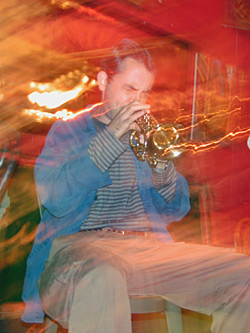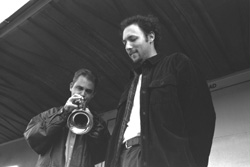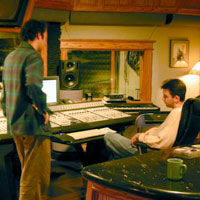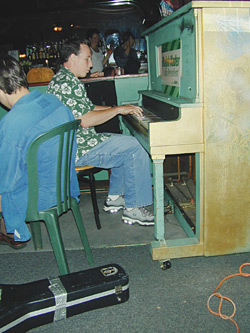Bios | Imagebank | Info | Links | Home

DEREK, MERCURY CAFE. PHTOTO: J.MOORE

PHTOTO: JOHN SCHOENWALTER

RMR STUDIO B. PHTOTO: J.MOORE

JUSTIN ADAMS & DEREK, MERCURY CAFE.
PHTOTO: J.MOORE
Tunestories
|
GARE DU NORD In the end, we used them both too. What you hear in the tune is just one melody on top of the other. The first time you hear them it's just the pure takes, very simple and straightforward. Then, they come back again in an edited form, all chopped up and bits moved around. A different but related melody, constructed from edited fragments of the parts as they were played. In part, it was an exercise in working with the idea of acoustic integrity first, and then disregarding integrity entirely, editing with wild abandon, and making none of the usual attempts to hide the manipulation. - JM |
|
|
PORTRAIT I really should let Derek write the notes for Portrait, as it's his tune. It was originally written for a young, talented jazz quintet which Derek was part of, along with Rudy, Artie, and some other players. Derek translated it into 4/4 time signature (it was originally in 7/8) and rearranged it only slightly. He passed it to me and I went nuts with beats and things. I quite like the tune: it is so smooth and gritty at the same time. I love Derek's chords. It's the second tune we ever worked on together, and the first that really worked out. It was very exciting to both of us at the time! It was beautiful to hear what Justin did with the piano parts. Small, subtle things, a grace note here and there maybe, but with a clear forwardness and uncomplexity which still makes me smile when I hear it. - JM
|
|
|
SOFT DAY We had Rudy Royston, who is a fantastic drummer, in the studio with the idea of making some sampled loops which we'd use as maybe the basis for a new tune. On somebody's suggestion, I went out in the room and just did some improv stuff on Dumbek with him on Kit, and we got into this very cool, open groove that had a nice development to it. Listening back to the takes later, on a different date, the musicality of that groove became apparent as a piece on it's own. Derek had been working on some chord ideas which I rather liked, and we figured we'd try them out against it. Threw a couple of mics up on the piano, and rolled it a time or two, laid down tracks, and that was the basis for the tune. I'd wanted to find some ambient sounds to act as a landscape for it, to situate it in a place. For me, the mood of the tune was fitting very well with the mood of a certain recording I'd made on a special day in northern California in spring 1997. Also fitting the mood and finding their way into the tune were some textural elements which were originally prepared for a sound installation I'd put on in '96 at Denver's Union Terminal Railway building. - JM |
|
|
INFRALUDE - JM |
|
|
KHIVA The melody was essentially already there in the recording. The notes of it arose spontaneously while listening and playing. We felt Mark McCoin, being such a textural player, and having great ears, would bring a lot of breath to the tune. Artie Moore was an obvious choice as well. It's all about the ability to listen. I sketched out a very open structure for it before the recording date, discussed rhythm ideas with Mark, and we did a few takes of the tune, improvising around the basic chords and structure, and one of those takes is what you hear on the record. We put the insect recording from my grandmother's house up on the faders, and Gannon controlled it as we were playing. (That part being structurally important to the music, and being entirely up to him how it was worked during the take, naturally he gets the musician credit for Faders.) - JM |
|
|
RIVETGUN - JM |
Bios | Imagebank | Info | Links | Home